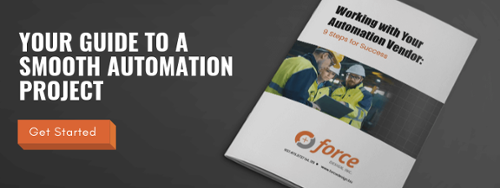
If you’re like most small to medium sized manufacturers, you spent, or plan to spend, a large amount of time and careful consideration choosing an automation integrator. Don’t neglect putting the same degree of thought into appointing a team from your company who will work with them. After all, you’re making a sizeable investment in a custom machine that your staff will rely on each day, so it makes sense to develop a partnership with the vendor as it’s being created.
The purposes of this internal team are to provide the vendor with critical details about the project and to be a liaison between the vendor and the rest of your company. It’s helpful to include some of the staff who helped select the vendor and who did the initial planning because they know how the project has evolved and why certain decisions were made. But this team has a different job than the vendor selection group did, so you will probably pick some new people too.
Your new automation solution is most likely to meet your needs if you assemble a team that can do these things:
- Answer questions about your processes and what you want to accomplish, including specific requirements of the procedures or final product, and ergonomic or safety concerns.
- Make some of the critical decisions about the project (e.g. timelines, design reviews, procedures), or secure decisions from the appropriate party and report back to the vendor.
- Commit the required time to meet regularly, respond to vendor inquiries quickly, and meet deadlines (design review, supplying test parts, preparing space).
- Buy into the project and prepare the rest of the company for the changes, including answering their questions, showing enthusiasm, and envisioning the big picture and benefits of adding automation.
- Discuss technical requirements, equipment, and skills specific to the task being automated.
- Have a realistic understanding of the cultural shift and the impact it will have on jobs.
- Communicate clearly within company and with the vendor.
- Manage your company’s responsibilities for the project (e.g. serving as a point person for the vendor and your team, tracking progress, checking in and reporting delays/changes, and having a sense of how all of the pieces come together). These tasks can be shared, but usually one project manager takes on this role.
Focus on the capabilities and tasks required rather than strictly on job titles. A cross-departmental team, sized to balance expertise and efficiency, helps address the project comprehensively. For example, you might include staff from leadership/management (depending on the size of your company), engineering, operations management, machinists/operators, purchasing, safety, quality assurance, maintenance, and IT. And keep in mind the time commitment required of participants – ideally the same group should see the project through to completion.
During this time, you might also become aware of gaps in your employees’ skill sets, especially in terms of troubleshooting, long-term maintenance, and any plans you have to redeploy or program equipment beyond the original project scope. You’ve probably talked about this to some degree in earlier stages, but now’s a good time to plan in detail for future staffing or continuing education needs.
Throughout the project, try to remember you’re not just the vendor’s client: you’re their collaborator. You team’s feedback and willingness to engage influences the outcome of the project. Contact us about your automation ideas today – we can help.




